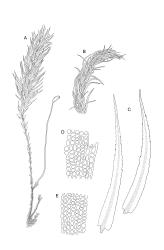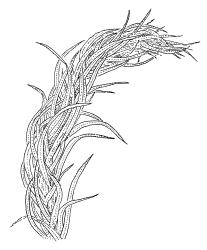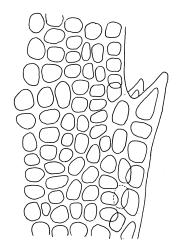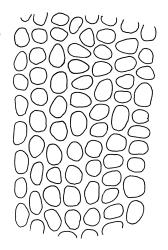- ≡ Mnium paramattense Müll.Hal., Syn. Musc. Frond. 2, 555 (1851)
- ≡ Rhizogonium paramattense (Müll.Hal.) Reichardt, Reise Novara 1, 180 (1870)
Rhizogonium spiniforme sensu Sykes (1977, p. 58)
Plants robust, brown- or dark green, unbranched or forked near base, forming dense tufts. Stems erect, unbranched, red-brown below, green above, c. 15–50 mm high, not complanate, in cross-section ± three-angled, with 2–3 layers of small, thick-walled cortical cells (the outermost strongly pigmented) surrounding a medulla of larger, firm-walled cells and a weak central strand, beset at base with red-brown, strongly papillose rhizoids. Leaves wide-spreading below (excluding the reduced basal leaves) and progressively more erect towards the stem apex, flexuous when dry, symmetric, linear-lanceolate with an acuminate apex, not concave, not decurrent, partially bistratose and plane at margins, serrate nearly to base by up to 25 pairs of single-celled teeth, 4.5–6.0 × 0.3 mm, becoming progressively reduced and scale-like near stem base. Upper laminal cells firm-walled, irregular in shape (mostly rounded-oblong, isodiametric, or oblate), not exceeding 1.5:1, 15 µm or less in greater diam., scarcely differentiated in lower part of leaf, usually with a few rows of cells at insertion ± longer (to 4:1); marginal cells partially bistratose (forming in parts distinct wings that are best viewed in cross-section) but otherwise not differentiated; alar cells not differentiated. Costa concolorous, c. 120 µm wide near leaf base (flaring to 150 µm or more at extreme base), evenly tapered, c. 60–75 µm at mid leaf, excurrent, bearing numerous single or paired abaxial spines for ⅓–½ its length, in cross-section plano-convex, with c. 8 median guide cells, and large abaxial and adaxial stereid bands.
Dioicous. Perichaetia single or in clusters at base of stem, with leaves linear-lanceolate, costate, c. 2 mm. Perigonia scattered on lower stem (to 7 or more per stem, and extending at least 8 mm above stem base), with bracts c. 1.5 mm, costate, acuminate from an obovate, concave, and pigmented base, with numerous antheridia and filiform, 6–8-celled paraphyses. Setae 20–42 mm, straight, smooth, c. 180 µm diam., twisting weakly to the left, red-brown; capsules inclined, oblong-cylindric, asymmetric, 2.3–2.6 mm, smooth, moderately constricted below the mouth when dry, pale brown; exothecial cells not in distinct longitudinal ranks, oblong, with uniformly thickened walls, smooth, mostly 45–60 × 18–21 µm; annulus vesicular and persistent; operculum rostrate from a conic base, c. 1 mm. Exostome teeth pale yellow-brown, narrowly lanceolate, inserted close to rim, c. 700 µm long, bordered, outer surface transversely striate in lower half, baculate above, inner surface lamellate; endostome from a high membrane; segments as long as teeth, keeled, variably perforate; cilia in groups of 3, well-developed and nodose. Calyptra not seen. Spores ± spherical, 15–18 µm, very finely papillose.
Scott & Stone 1976, pl. 57 (as Rhizogonium parramattense); Streimann 2002, fig. 62, 1–2; pl. 29.
Pyrrhobryum paramattense can be distinguished from P. mnioides subsp. contortum (both are dioicous) by having flexuose (not crisped) dry leaves that are much reduced in size toward the stem base, differently positioned sex organs, shorter basal leaf cells and no leaf decurrencies. At least in the herbarium, the overall aspect of the two species is quite different.
Pyrrhobryum paramattense is a dioicous segregate of the synoicous and pantropical P. spiniforme. Inoue & Iwatsuki (1976) studied the cytotaxonomy of the "Rhizogonium spiniforme complex" and noted that the synoicous and autoicous conditions are correlated with the chromosome number n=12 and the dioicous condition with n=6. They considered synoicy to be "one of the most important characters" for the recognition of "R. spiniforme var. spiniforme" and suggested that varietal status may be more appropriate for its dioicous allies.
K; NI: N Auckland (Maungaraho Rock Scenic Reserve, Puketi State Forest, Waipoua Forest), S Auckland (Mayor I.); Ch (Tuku-a-Tamatea Reserve).
Australasian. Mainland Australia*, Norfolk I.*, Lord Howe I.*
According to Sykes (1977, p. 58) this species, which he cited as Rhizogonium spiniforme (Hedw.) Bruch, is a "common and locally abundant epiphyte and common terrestrial of the wet and dry forest" on Raoul I. in the Kermadecs. In N Auckland it occurs on rotten wood, tree trunks (Elaeocarpus and Weinmannia), and on rock in warm temperate forest of varying species composition. The single documented Chatham I. collection grew on silty peat at the margin of a small stream which was "evidently frequently flooded". Occurring from c. 40–520 m in the Kermadec Is, and recorded from c. 140–305 m on North I.
Pyrrhobryum paramattense is known in the North I. by at least six well-documented collections (three being from Waipoua Forest). Sainsbury (1955, p. 299) excluded Rhizogonium spiniforme from the flora as a "doubtful species". My interpretation of Sainsbury’s comments is that he did not see either of the Cunningham collections he mentioned. Presumably the two specimens cited by Dixon (1926, p. 222) are Cunningham collections. I have not seen the Cunningham material. Whittier’s (1976, p. 174) claim that R. spiniforme occurs in New Zealand is presumably founded on Dixon’s comments.
At least 16 collections are known from the Kermadec Is., and the dioicous sexuality of several of these collections can be readily demonstrated. Repeated efforts to locate antheridia in North I. material have failed.
Material has been seen in BM (herb. Hampe) which is labelled in Müller’s script: "Mnium (Rhizogonium) paramattense mihi"; it was collected from the Brisbane River by Dietrich in 1864. If original material (collected by Hügel) cannot be located, this material would be a suitable neotype.









